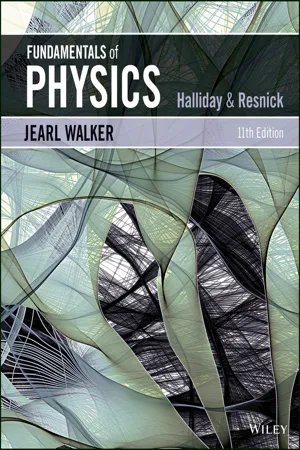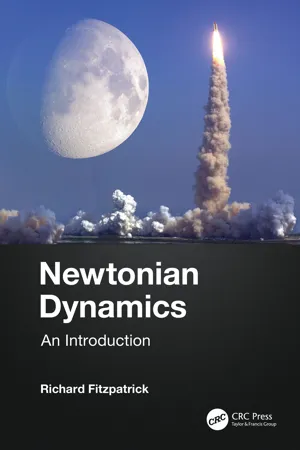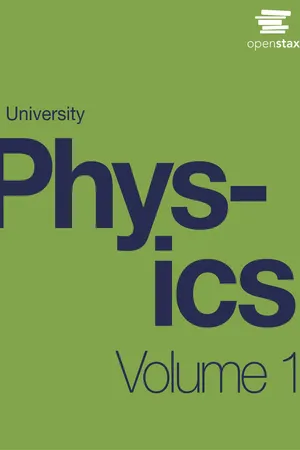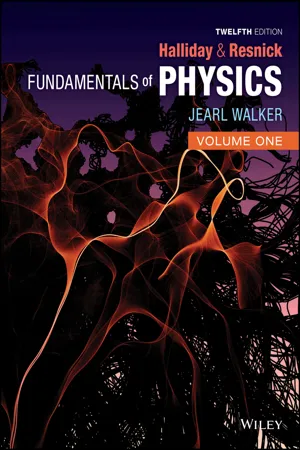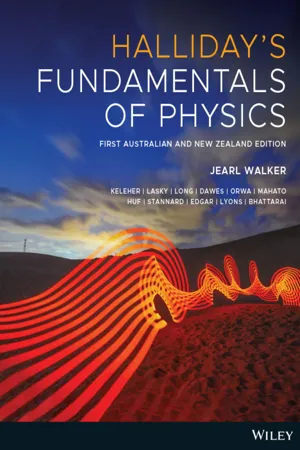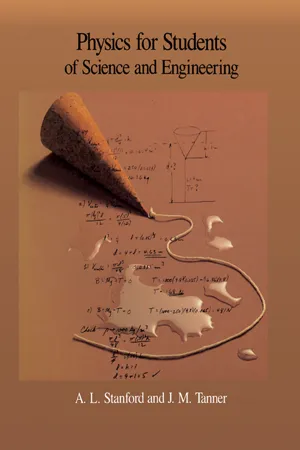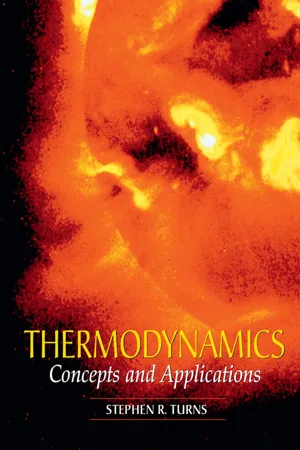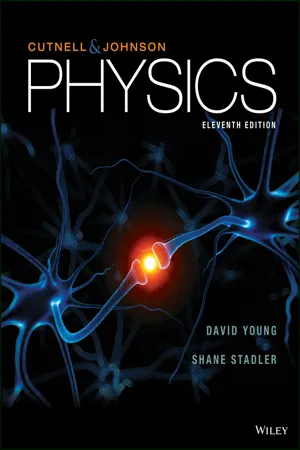Physics
Potential Energy and Energy Conservation
Potential energy is the energy stored in an object due to its position or configuration. It can be converted into kinetic energy when the object moves. Energy conservation refers to the principle that the total energy in a closed system remains constant over time, with energy being transformed from one form to another but not created or destroyed.
Written by Perlego with AI-assistance
Related key terms
1 of 5
12 Key excerpts on "Potential Energy and Energy Conservation"
- eBook - PDF
- David Halliday, Robert Resnick, Jearl Walker(Authors)
- 2018(Publication Date)
- Wiley(Publisher)
What Is Physics? One job of physics is to identify the different types of energy in the world, especially those that are of common importance. One general type of energy is potential energy U. Technically, potential energy is energy that can be associated with the configuration (arrangement) of a system of objects that exert forces on one another. C H A P T E R 8 Potential Energy and Conservation of Energy 8-1 POTENTIAL ENERGY Learning Objectives After reading this module, you should be able to . . . ● A force is a conservative force if the net work it does on a particle moving around any closed path, from an initial point and then back to that point, is zero. Equivalently, a force is conservative if the net work it does on a particle moving between two points does not depend on the path taken by the particle. The gravitational force and the spring force are conservative forces; the kinetic frictional force is a nonconservative force. ● Potential energy is energy that is associated with the configuration of a system in which a conservative force acts. When the conservative force does work W on a particle within the system, the change ∆U in the potential energy of the system is ∆U = −W. If the particle moves from point x i to point x f , the change in the potential energy of the system is ΔU = − ∫ x f x i F(x) dx. ● The potential energy associated with a system consist- ing of Earth and a nearby particle is gravitational potential energy. If the particle moves from height y i to height y f , the change in the gravitational potential energy of the particle–Earth system is ∆U = mg( y f − y i ) = mg ∆y. ● If the reference point of the particle is set as y i = 0 and the corresponding gravitational potential energy of the system is set as U i = 0, then the gravitational potential energy U when the particle is at any height y is U( y) = mgy. ● Elastic potential energy is the energy associated with the state of compression or extension of an elastic object. - eBook - PDF
- David Halliday, Robert Resnick, Jearl Walker(Authors)
- 2020(Publication Date)
- Wiley(Publisher)
150 What Is Physics? One job of physics is to identify the different types of energy in the world, especially those that are of common importance. One general type of energy is potential energy U. Technically, potential energy is energy that can be associated with the configuration (arrangement) of a system of objects that exert forces on one another. C H A P T E R 8 Potential Energy and Conservation of Energy 8-1 POTENTIAL ENERGY Learning Objectives After reading this module, you should be able to . . . ● A force is a conservative force if the net work it does on a particle moving around any closed path, from an initial point and then back to that point, is zero. Equivalently, a force is conservative if the net work it does on a particle moving between two points does not depend on the path taken by the particle. The gravitational force and the spring force are conservative forces; the kinetic frictional force is a nonconservative force. ● Potential energy is energy that is associated with the configuration of a system in which a conservative force acts. When the conservative force does work W on a particle within the system, the change ∆U in the potential energy of the system is ∆U = −W. If the particle moves from point x i to point x f , the change in the potential energy of the system is ΔU = − ∫ x f x i F(x) dx. ● The potential energy associated with a system consist- ing of Earth and a nearby particle is gravitational potential energy. If the particle moves from height y i to height y f , the change in the gravitational potential energy of the particle–Earth system is ∆U = mg( y f − y i ) = mg ∆y. ● If the reference point of the particle is set as y i = 0 and the corresponding gravitational potential energy of the system is set as U i = 0, then the gravitational potential energy U when the particle is at any height y is U( y) = mgy. ● Elastic potential energy is the energy associated with the state of compression or extension of an elastic object. - eBook - ePub
Newtonian Dynamics
An Introduction
- Richard Fitzpatrick(Author)
- 2021(Publication Date)
- CRC Press(Publisher)
CHAPTER 5 Conservation of Energy DOI: 10.1201/9781003198642-5 5.1 Introduction Nowadays, the conservation of energy is undoubtedly the single most important idea in physics. Strangely enough, although the basic idea of energy conservation was familiar to scientists from the time of Newton onward, this crucial concept only moved to center stage in physics in about 1850 (i.e., when scientists first realized that heat was a form of energy). According to the ideas of modern physics, energy is the fundamental substance that makes up all things in the universe. Energy can take many different forms; for instance, potential energy, kinetic energy, electrical energy, thermal energy, chemical energy, nuclear energy, etcetera. In fact, everything that we observe in the world around us represents one of the multitudinous manifestations of energy. There exist processes in the universe that transform energy from one form into another; for instance, mechanical processes (which are the focus of this book), thermal processes, electrical processes, nuclear processes, etcetera. However, all of these processes leave the total amount of energy in the universe invariant. In other words, whenever, and however, energy is transformed from one form into another, it is always conserved. For a closed system (i.e., a system that does not exchange energy with the rest of the universe), the previous law of universal energy conservation implies that the total energy of the system in question must remain constant in time. 5.2 Energy Conservation During Free-Fall Consider a mass, m, that is falling vertically under the influence of gravity. We already know how to analyze the motion of such a mass. Let us employ this knowledge to search for an expression for the conserved energy during this process. (Note that this is clearly an example of a closed system, involving only the mass and the gravitational field.) The physics of free-fall under gravity is summarized by the three equations (2.16)–(2.18) - eBook - PDF
- William Moebs, Samuel J. Ling, Jeff Sanny(Authors)
- 2016(Publication Date)
- Openstax(Publisher)
Understanding the concept of energy 372 Chapter 8 | Potential Energy and Conservation of Energy This OpenStax book is available for free at http://cnx.org/content/col12031/1.5 conservation is the important thing, not the particular equation you use to express it. Problem-Solving Strategy: Conservation of Energy 1. Identify the body or bodies to be studied (the system). Often, in applications of the principle of mechanical energy conservation, we study more than one body at the same time. 2. Identify all forces acting on the body or bodies. 3. Determine whether each force that does work is conservative. If a non-conservative force (e.g., friction) is doing work, then mechanical energy is not conserved. The system must then be analyzed with non-conservative work, Equation 8.13. 4. For every force that does work, choose a reference point and determine the potential energy function for the force. The reference points for the various potential energies do not have to be at the same location. 5. Apply the principle of mechanical energy conservation by setting the sum of the kinetic energies and potential energies equal at every point of interest. Example 8.7 Simple Pendulum A particle of mass m is hung from the ceiling by a massless string of length 1.0 m, as shown in Figure 8.8. The particle is released from rest, when the angle between the string and the downward vertical direction is 30°. What is its speed when it reaches the lowest point of its arc? Figure 8.8 A particle hung from a string constitutes a simple pendulum. It is shown when released from rest, along with some distances used in analyzing the motion. Strategy Using our problem-solving strategy, the first step is to define that we are interested in the particle-Earth system. Second, only the gravitational force is acting on the particle, which is conservative (step 3). We neglect air resistance in the problem, and no work is done by the string tension, which is perpendicular to the arc of the motion. - eBook - PDF
- David Halliday, Robert Resnick, Jearl Walker(Authors)
- 2021(Publication Date)
- Wiley(Publisher)
186 C H A P T E R 8 Potential Energy and Conservation of Energy 8.1 POTENTIAL ENERGY Learning Objectives After reading this module, you should be able to . . . 8.1.1 Distinguish a conservative force from a noncon- servative force. 8.1.2 For a particle moving between two points, iden- tify that the work done by a conservative force does not depend on which path the particle takes. 8.1.3 Calculate the gravitational potential energy of a particle (or, more properly, a particle–Earth system). 8.1.4 Calculate the elastic potential energy of a block– spring system. Key Ideas ● A force is a conservative force if the net work it does on a particle moving around any closed path, from an initial point and then back to that point, is zero. Equiva- lently, a force is conservative if the net work it does on a particle moving between two points does not depend on the path taken by the particle. The gravitational force and the spring force are conservative forces; the kinetic frictional force is a nonconservative force. ● Potential energy is energy that is associated with the configuration of a system in which a conservative force acts. When the conservative force does work W on a particle within the system, the change ∆U in the poten- tial energy of the system is ∆U = −W. If the particle moves from point x i to point x f , the change in the potential energy of the system is ΔU = − x t x f F(x) dx . ● The potential energy associated with a system con- sisting of Earth and a nearby particle is gravitational potential energy. If the particle moves from height y i to height y f , the change in the gravitational potential energy of the particle–Earth system is ∆U = mg( y f − y i ) = mg ∆y. ● If the reference point of the particle is set as y i = 0 and the corresponding gravitational potential energy of the system is set as U i = 0, then the gravitational potential energy U when the particle is at any height y is U( y) = mgy. - David Halliday, Jearl Walker, Patrick Keleher, Paul Lasky, John Long, Judith Dawes, Julius Orwa, Ajay Mahato, Peter Huf, Warren Stannard, Amanda Edgar, Liam Lyons, Dipesh Bhattarai(Authors)
- 2020(Publication Date)
- Wiley(Publisher)
When the mechanical energy of a system is conserved, we can relate the sum of potential energy and kinetic energy at one instant to that at another instant without considering the intermediate motion and without finding the work done by the forces involved. CHAPTER 8 Potential energy and conservation of energy 123 8.3 Reading a potential energy curve LEARNING OBJECTIVES After reading this module, you should be able to: 8.3.1 given a particle’s potential energy as a function of its position x, determine the force on the particle 8.3.2 given a graph of potential energy versus x, determine the force on a particle 8.3.3 on a graph of potential energy versus x, superimpose a line for a particle’s mechanical energy and determine the particle’s kinetic energy for any given value of x 8.3.4 if a particle moves along an x axis, use a potential‐energy graph for that axis and the conservation of mechanical energy to relate the energy values at one position to those at another position 8.3.5 on a potential‐energy graph, identify any turning points and any regions where the particle is not allowed because of energy requirements 8.3.6 explain neutral equilibrium, stable equilibrium, and unstable equilibrium. KEY IDEAS • If we know the potential energy function U(x) for a system in which a one‐dimensional force F(x) acts on a particle, we can find the force as F (x) = - dU dx . • If U(x) is given on a graph, then at any value of x, the force F(x) is the negative of the slope of the curve there and the kinetic energy of the particle is given by K (x) = E mec - U (x) , where E mec is the mechanical energy of the system. • A turning point is a point x at which the particle reverses its motion (there, K = 0). • The particle is in equilibrium at points where the slope of the U(x) curve is zero (there, F(x) = 0). Once again we consider a particle that is part of a system in which a conservative force acts.- eBook - ePub
- A. L. Stanford, J. M. Tanner(Authors)
- 2014(Publication Date)
- Academic Press(Publisher)
5Work, Power, and Energy
Publisher Summary
This chapter discusses physical quantities and concepts necessary for the understanding of energy and its associated conservation principle. In the nonscientific world, work is often thought of in terms of some physical or mental effort. In physics, however, the term work is defined precisely. Doing work requires the use of force, and work on a body does not take place without displacement of that body. The rate at which work is done is often of interest in practical applications. Power is the measure of the rate at which work is being done. It is sometimes convenient to express power in terms of a constant force acting on an object moving at a constant velocity. A unit commonly used for measuring electrical power is the kilowatt . A particle or a system of particles that has the capacity to do work is said to possess energy, a physical quantity associated with the particle or system that may take many forms. In the technical sense, however, a system that has the ability to do work is said to have energy. Energy is a scalar quantity that is usually expressed in terms of the same units as those of work.This chapter introduces one of the most important and perhaps the most far-reaching of all principles in the sciences—the conservation of energy. A conservation principle is a rule or a natural law that specifies that the value of a physical quantity does not change during the course of a physical process but remains constant. The quantity that does not change is said to be conserved. The simplicity of conservation principles makes them concise expressions of natural law and powerful tools of scientific analysis. Conservation of energy is only one of a number of conservation principles that students of science or engineering will encounter. The significance and the usefulness of these principles should become apparent to the student as they are used to analyze and interpret physical phenomena. - eBook - PDF
The Mechanical Universe
Mechanics and Heat, Advanced Edition
- Steven C. Frautschi, Richard P. Olenick, Tom M. Apostol, David L. Goodstein(Authors)
- 2008(Publication Date)
- Cambridge University Press(Publisher)
Something is the same at the end of the ball's motion as it was at the beginning. That something is its energy. The recognition of energy conservation increases our understanding and simplifies analysis of the motion. The concept of energy was invented precisely because something is conserved. Then why are politicians and gas company executives telling us to conserve energy? To answer this burning question, we need a precise and quantitative definition of energy. 10.2 WORK AND POTENTIAL ENERGY In ordinary speech, work refers to any exertion maintained for some time. But in physics the word work is used more precisely, to describe an energy transfer from one thing to another carried out by a force acting over distance. For the simple case of a constant force of magnitude F moving an object a distance h parallel to the force, the work W done by the force is defined as IV = Fh. (10.1) For example, if you lift an object of mass m in such a way that it doesn't accelerate, then the lifting force is equal to the weight mg of the object. Since mg is constant, the work done to raise the object up to height h is W = mgh. (10.2) Note that since the work all goes into potential energy U in the example, the gravitational potential energy in the uniform field near the earth can be given the simple form U = mgh. (10.3) Now that we have a definition of work, let's go back and follow energy conservation through the various stages of Galileo's experiment. First, Galileo lifts the ball a height h, performing work on it by applying a force to balance the preexisting force of gravity. We say that work is done by the force that Galileo applies, or alternatively that work is done against the force of gravity. In any case overall energy is conserved; the work represents a transfer from the world outside the ball (namely, from Galileo) to the ball. - Available until 16 Feb |Learn more
Classical Mechanics
A Computational Approach with Examples Using Mathematica and Python
- Christopher W. Kulp, Vasilis Pagonis(Authors)
- 2020(Publication Date)
- CRC Press(Publisher)
5.1.12 ), we see that solving problems using conservation of energy requires only that we compare one state of the system to another. For example, suppose we drop a rock starting at rest from a height of 5 m above the ground and we want to know the kinetic energy of the rock after it fell 2 m. All we need is to know is the initial kinetic energy (which is zero) and the initial and final potential energies in order to obtain the final kinetic energy (and thus the speed). We don’t need information about the state of the system during the actual fall!Equation (5.1.12 ) also tells us that if the potential energy of the system decreases, its kinetic energy must increase and vice versa, in order to maintain the equality of both sides of the equation. The ability to interpret the meanings behind equations such as (5.1.8 ) and (5.1.12 ) is an important skill for physicists.Example 5.1: Simple harmonic motion and conservation of energyConsider a mass m on a spring with spring constant k performing simple harmonic motion with amplitude A. The force is given by Hooke’s law F = −kx where x is the displacement from equilibrium.(a) Find the total mechanical energy in terms of A.(b) Find an expression for the turning points in the motion, the points at which the velocity v of the particle is zero and the mass turns around, as a function of the total mechanical energy E and spring constant k.Solution:(a) We will solve this problem using energy conservation. In order to use energy conservation, we need to first find the potential energy associated with the spring. The potential energy associated with the force of the spring is called the elastic potential energy - eBook - PDF
Thermodynamics
Concepts and Applications
- Stephen R. Turns(Author)
- 2006(Publication Date)
- Cambridge University Press(Publisher)
(See Ref. [4].) Rudolf Clausius (1822–1888) wrote in 1850 one of the most succinct and modern-sounding statement of the energy conservation principle [6]: “The energy of the universe is constant.” (Clausius also named the property entropy and presented clear statements of the second law of thermodynamics. We will consider these concepts in Chapter 6.) 5.2 ENERGY CONSERVATION FOR A SYSTEM We begin our study of the conservation of energy principle by considering a system of fixed mass. We start by explicitly transforming the generic conservation principles from Chapter 1 (Eqs. 1.1 and 1.2) to statements of energy conservation. By defining X to be energy E, Eq. 1.1, which applies to the time interval t 2 t 1 , becomes E in E out E generated E stored E sys (t 2 ) E sys (t 1 ). (5.1) Similarly, by defining to be the time rate of energy Eq. 1.2, which applies to an instant, becomes (5.2) Figure 5.1 shows a system with superimposed arrows representing the various terms in these equations. Our task now is to associate each term in these conservation of energy equations with particular forms of energy for various physical situations. We consider rather general statements of energy conservation in which all forms of energy and their interconversions are allowed. Since we include all forms of energy in our energy accounting, no generation term appears. Our only restriction is the exclusion of nuclear transformations; the proper treatment of nuclear transformations and the relationship between mass and energy are beyond the scope of this book. E # stored . E # generated E # out E # in E # , X # At this point, you may find it useful to review the detailed discussion of systems and control volumes in Chapter 1. - eBook - ePub
- E. Atlee Jackson(Author)
- 2012(Publication Date)
- Dover Publications(Publisher)
models (simplified pictures) of atoms, molecules, gases, and solids will illustrate the various types of interactions between particles. Finally, we shall consider some of the important modifications of these classical models that are required by quantum mechanics.2. KINETIC AND POTENTIAL ENERGY
To begin with, let us consider a particle moving in space as it is described in classical mechanics. The position of the particle r (t ) = x (t )i + y (t )j + z (t )k [where (i, j, k ) are the unit vectors in the (x , y , z ) directions] generally varies in time and has a velocityIf the particle has a mass m, it is said to have a kinetic energy (sometimes called the translational energy )(1)If a force F acts on the particle, its velocity will change according to Newton’s law(2)If no force acts on the particle, then it follows from Equation (2) that v is independent of the time, and consequently the kinetic energy is also a constant. We can also see this from the fact that(3)which vanishes if F vanishes.Now the force that acts on the particle generally depends on the position of the particle r and sometimes also on the velocity (e.g., frictional forces, or the force on a charged particle moving in a magnetic field). If the force depends only on r and if it can be expressed in terms of the gradient of some function Φ - eBook - ePub
- John D. Cutnell, Kenneth W. Johnson, David Young, Shane Stadler(Authors)
- 2018(Publication Date)
- Wiley(Publisher)
Problem-Solving Insight
One electron volt is the magnitude of the amount by which the potential energy of an electron changes when the electron moves through a potential difference of one volt.Since the magnitude of the change in potential energy is|q0 ΔV| = |(−1.60 × 10−19 C) × (1.00 V)| = 1.60 × 10−19 J, it follows that1 eV = 1.60 ×10J− 19One million(10+6 )electron volts of energy is referred to as one MeV, and one billion(10+9 )electron volts of energy is one GeV, where the “G” stands for the prefix “giga” (pronounced “jig′a”).In Equation 19.3 , we have seen that the electric potential is the electric potential energy per unit charge. In previous chapters, we have seen that the total energy of an object, which is the sum of its kinetic and potential energies, is an important concept. Its significance lies in the fact that the total energy remains the same (is conserved) during the object's motion, provided that nonconservative forces, such as friction, are either absent or do no net work. While the sum of the energies at each instant remains constant, energy may be converted from one form to another; for example, gravitational potential energy is converted into kinetic energy as a ball falls. We now include the electric potential energy EPE as part of the total energy that an object can have:=E ⏟Total energy+⏟1 2mυ 2Translational kinetic energy+⏟1 2Iω 2Rotational kinetic energy+m a g⏟Gravitationalpotential energy+⏟1 2kx 2Elasticpotential energyEPE ⏟Electricpotential energyIf the total energy is conserved as the object moves, then its final energy Ef is equal to its initial energy E0 , orEf = E0. Example 4 illustrates how the conservation of energy is applied to a charge moving in an electric field.Analyzing Multiple-Concept Problems
EXAMPLE 4 | The Conservation of Energy
A particle has a mass of1.8 × 10−5 kgand a charge of+3.0 × 10−5 C. It is released from rest at point A and accelerates until it reaches point B, as Figure 19.5 a shows. The particle moves on a horizontal straight line and does not rotate. The only forces acting on the particle are the gravitational force and an electrostatic force (neither is shown in the drawing). The electric potential at A is 25 V greater than that atB;in other words,V. What is the translational speed of the particle at point BA− VB= 25 V
Index pages curate the most relevant extracts from our library of academic textbooks. They’ve been created using an in-house natural language model (NLM), each adding context and meaning to key research topics.
